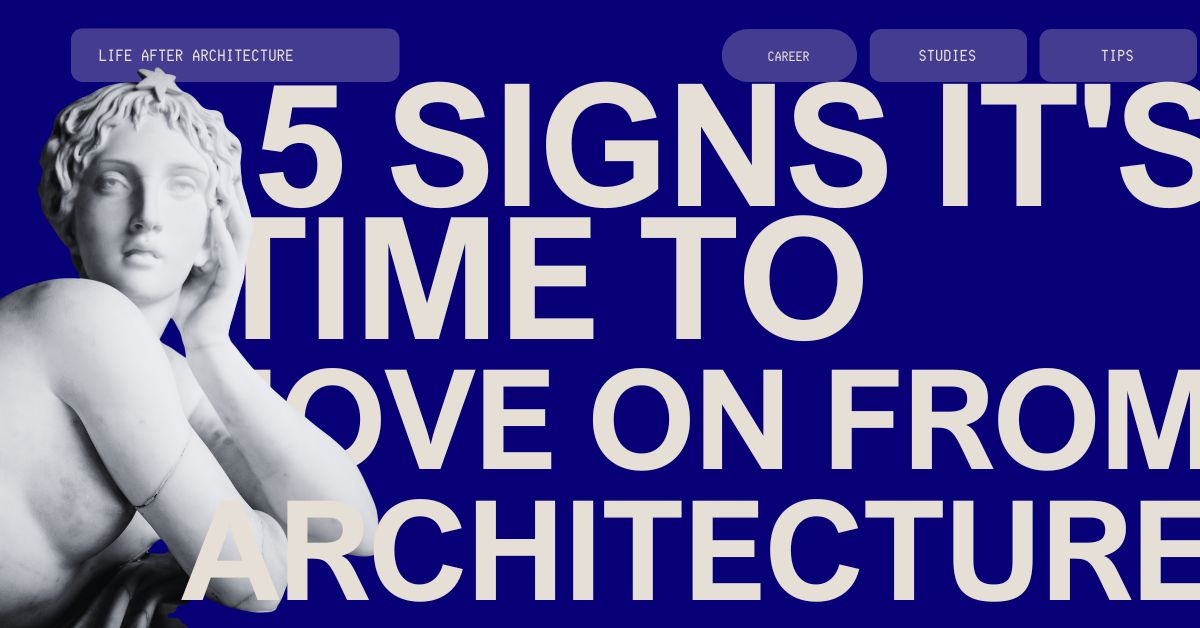Making the decision to leave behind a career in architecture wasn’t easy, especially after investing years of hard work and passion into the field. After years of studies, including a master’s abroad, and years of professional experience in Dutch, Czech, and Georgian architecture studios, I realized that it was time to let it go and move on.
In this blog post, I’ll share some of the key signs that led me to make the leap, and how recognizing these indicators can help you decide if a career change is right for you too.
1. Desire for More Flexibility
As an introvert, the traditional office environment was always a challenge for me. Spending the full week in a bustling studio drained my energy, making it difficult to stay creatively engaged.
What frustrated me even more was that, in many architecture studios, working from home wasn’t an option, even when the tasks were remotely perfectly doable. The rigid expectation of being physically present in the office, despite the advancements in technology that made remote work possible, left me feeling boxed in.
This lack of flexibility was a significant factor that led me to consider a career change.
So if you are an architect who needs to go to the office even when there is not much to do, or even when the tasks can absolutely be done from home, I feel you.
However, whether or not this factor is a tiebreaker, is really a personal choice. For me it was a big deal.
2. Lack of Growth Opportunities
Since 2019 I have lived and worked in the Czech republic. It might be interesting to tell the story how a Georgian ended up in the Czech Republic, but that’s whole another blog post.
As an architect working in a foreign country, I quickly realized that growth opportunities could be severely limited if you don’t speak the local language.
Unless you are in a region where there are lots of international studios – like, Netherlands or Denmark, the architecture industry is heavily focused on the local market, with most studios catering to domestic clients and projects.
This creates a significant barrier for architects who, like me, might be more comfortable or experienced in an international context. Without fluency in the local language, the ability to communicate effectively with clients, contractors, and colleagues can be hindered, limiting your role to support functions rather than leading projects.
If you are at the beginning stages of your career, those roles are great, but at some point, you grow resentful seeing your peers advancing their careers with titles while you stay in the supporting roles.
Additionally, the lack of international studios in some regions further narrows the field of opportunities. If you’re seeking to work on innovative, global projects or hoping to collaborate with diverse teams, you may find yourself stuck in a market that prioritizes local needs and traditional approaches.
These factors combined—language barriers, a focus on local markets, and the scarcity of international opportunities—can make it challenging to grow as an architect in certain regions. For me, this realization was a turning point. It led me to explore alternative careers where I could leverage my skills in a more global and flexible environment, ultimately guiding me toward web design, where the opportunities for growth and innovation felt limitless and I would not be dependent only on Czech market.
Of course, you can say that I should have learned Czech, but anyone who has actually tried to learn Czech, would agree that becoming fluent (that is very important to gain trust with the clients and contractors) is not that easy and takes many many years. And if you are about to put this much effort into something, it should be very much worth it, financially, in the first place.
Which leads me to the next point
3. Financial Dissatisfaction

Financial dissatisfaction is a common concern among architects, and it’s easy to see why.
Despite the years of education, training, and experience required to excel in the field, the financial rewards often don’t match the level of effort and expertise invested.
Many architects find themselves working long hours, under tight deadlines, and managing complex projects, only to be compensated at rates that don’t reflect the true value of their work.
The disparity between the expectations and the reality of an architect’s salary can lead to frustration and a sense of being undervalued.
But why does it happen in the first place? After all, if you asked any of my relatives, I was so lucky to be an architect as they think we earn a lot.
There are several reasons why architectural studios often struggle to pay architects salaries that truly reflect the level of effort, education, and expertise required in the field. One major factor is the intense competition in the architecture industry. Many studios, especially smaller firms, are forced to bid low to secure projects, which can significantly reduce their profit margins. This price competition can make it difficult for studios to generate the revenue needed to offer competitive salaries, even when the quality and complexity of their work are high.
Additionally, the architecture industry is heavily influenced by economic cycles. During economic downturns, investment in construction and development projects often decreases, leading to fewer opportunities for architects. Studios may experience financial strain during these periods, struggling to maintain a steady flow of work, which directly impacts their ability to pay higher wages.
The high overhead costs associated with running an architectural practice also play a role. Expenses such as office space, software licenses, insurance, and marketing can eat into profits, leaving less money available for employee salaries. Furthermore, the long timelines of architectural projects—often spanning months or even years—can delay payment from clients, creating cash flow challenges for studios.
Many studios also face challenges in collecting fees from clients, dealing with scope creep, and managing changes that arise during projects. These issues can lead to budget overruns, further straining a studio’s financial resources.
Lastly, there is a widespread undervaluing of architectural services in some markets. Clients may not fully appreciate the depth of work involved in designing a building, from initial concepts to final construction documents, which can lead to pressure on studios to lower fees.
These financial pressures on studios make it difficult for them to offer salaries that match the education, skill, and dedication required in the profession. This creates a challenging environment for architects, who may feel underpaid and undervalued despite their significant contributions.
As a foreign architect, this financial dissatisfaction was compounded by additional challenges.
Even with years of experience, I found it difficult to advance in my career due to language barriers and a lack of opportunities in the local market. This stagnation not only limited my professional growth but also kept my income at a level that didn’t align with my expertise or expectations.
Being unable to break through these barriers, despite having a strong portfolio and a wealth of experience, added to my frustration. I realized that if I wanted to achieve financial satisfaction and feel truly valued for my skills, I might need to pivot to a field where my background and talents could be better recognized and rewarded.
This realization played a significant role in my decision to transition to web design, where I found the potential for both professional growth and financial fulfillment that had been lacking in my architecture career.
4. Desire for Creative Freedom
One of the most compelling signs that it was time for me to move on from architecture was my growing desire for creative freedom.
In architecture, I often felt constrained not only by client demands but also by the reality that studios needed to take on projects that didn’t fully align with their creative vision just to stay profitable. This led to compromises that stifled my passion and left me feeling creatively unfulfilled.
Web design isn’t completely free of limits, but the big difference is that you can choose to work with clients who like your style and ideas, if you set up your web design business wisely from the beginning.

In architecture, studios often have to take on projects just to stay in business, even if those projects don’t really fit with their creative vision. This can make the work feel less exciting and more like a chore.
But in web design, you have more control. You can pick clients who appreciate your creativity and let you explore your ideas, because unlike architecture, you are not limited with your region and you can choose clients from a larger pool. This makes the work more enjoyable and fulfilling, because you’re working on projects that truly inspire you.
5. Feeling Disconnected from the Work

Another clear sign that it might be time to move on from your architecture career is when you start feeling disconnected from the work you’re doing.
If you no longer feel a personal connection or pride in the projects you’re working on, it could mean that your heart isn’t in architecture anymore.
This often happens when you’re forced to compromise on your creative vision, whether you’re working for a studio or running your own business.
When the projects don’t excite you or align with what you believe in, the work can start to feel empty, more like just going through the motions rather than creating something meaningful. If you find yourself feeling this way, you have basically two possibilities: either change your approach and build your career or business in a way that guarantees more projects that align with your approach, or consider exploring new paths where you can reconnect with your passion and find fulfillment in your work again.
In my case, staying in architecture and trying to build my own freelance business was not that great idea due to the language bareer. Now when I look back, it was not actually a great reason. Having the knowledge I have now about building a business that aligns with your vision, I could have found a work-around.
Insetad, I decided to leave the field and make the change in the field from outside.
I dedicated lots of time reading and learning more about business, particularly running a successful creative business. This knowledge is the foundation of what I do now – helping architects create a polished, strategic online presence to attract the right type of clients.
Conclusion
Deciding to leave your job as an architect can be a big decision. If you’re feeling bored with your work, struggling to move up in your career, or finding it hard to be creative because of the rules and client demands, it might be time to think about trying something new.
Changing careers can bring back excitement and make you happier with what you do. If you notice these signs, it’s a good idea to think about what you really enjoy and look for a job that makes you feel excited and proud. Finding a path that fits your passions can make a big difference in how much you enjoy your work.
